Review of the best and warmest insulating jackets
This article explains the various different types of insulating mid-layer jackets (like down, primaloft and Buffalo), compares the advantages and disadvantages of each, and offers some recommendations.
First written in 2012. Updated March 2020. Recently overhauled in light of the popularity of my other comparison articles such as base layers, camping mats, bivy bags, camping stoves and multi fuel stoves (see the complete list here).
*NEW* – Comparison of Bikepacking Bags
The Best Mid Layers
The best mid layers explained, compared and reviewed.
–
–
What is a Mid Layer?
Mid layers are the garments whose primary purpose is insulation. They are generally worn on top of a base layer and, when conditions dictate, beneath an outer ‘shell’ layer. Unlike base and outer layers, you might wear more than one midlayer at a time if it’s cold enough.
A midlayer’s job is to trap as much of your body heat is as possible. Simple as that. The base layer can sort out any sweat and the outer shell can worry about wind and rain.
A thick woolly jumper or a cosy university hoodie are examples of insulating midlayers. What differentiates a good outdoor garment from a high street item is:
The Cut & Design
Outdoor kit tends to be closer fitting to minimise excess material, making a garment smaller and lighter. They also tend to have features like a high collar, adjustable cuffs and conveniently located pockets.
The Warmth-to-Size/Weight Ratio
A big woolly coat might keep you warmer than an expensive fleece from an outdoors shop but if it won’t fit in your rucksack then it’s not going to be much use.
What is the Best Mid Layer?
If it were just warmth-to-weight that was the issue then down jackets would easily be the best mid layers. However, there are other factors such as how robust they are, can you ventilate and manage your temperature levels, and how they hold up in wind and rain (hint: down jackets are not good at any of those things).
Below is an overview of the four most common types of mid layers (click to jump straight to them):
- Fleece
- Pile+Pertex Smocks (e.g. Buffalo)
- Insulated Synthetic Jackets (e.g. Primaloft)
- Down Jackets
The pros and cons of each are listed and compared to the other mid layers.
Did you know I have a whole series of Comparison articles?
They include: Base Layer Materials, Camping Mats and Bivy Bags. Browse them all here >>
Best Mid Layer Comparison Chart
Detailed mid layer descriptions are below but first a table to compare the materials. Practicality includes how tough they, how breathable and how comfortable to wear on the move. Warmth:Weight Ratio.
| Type | Warmth | Warmth:Weight Ratio | Practicality | Recommended |
| Fleece | |
|
|
|
| Pile+Pertex Smocks (e.g. Buffalo) | |
|
|
Buffalo Mountain Shirt ➜ |
| Synthetic Insulated Jackets (e.g. Primaloft) | |
|
|
Rab Xenon ➜ |
| Down Jackets | |
|
|
Rab Neutrino ➜ |
–
1. Fleeces
–
–
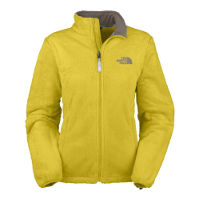
Fleece Mid Layers
Warmth: Low
Warmth-Weight Ratio: Low
Practicality: Good
Cost: Low
What is fleece?
Fleece is the name given to a range of materials made from synthetic fibres which are commonly used for insulating clothing. There is nothing fancy about them. A typical fleece top might not be any warmer than the jumper your gran knitted you for Christmas but the design and cut will probably be a little more suited to outdoor pursuits (unless your gran’s a real pro).
How does Fleece Insulate?
Fleece tends to be lighter than wool for the same level of insulation. It also retains much of its insulating properties when wet and, since it’s “hydrophobic” (meaning that it only holds a small amount of water) it will dry more rapidly too.
There are plenty of types of different fleece with different names and claims, some of which may be more revolutionary than others. As a broad rule of thumb, the thicker, furrier ones tend to be warmer but less wind-resistant whilst the thinner, tougher looking ones aren’t as warm but offer some wind protection.
Cost
£10-£100+. The fleece I bought for £10 over 10 years ago has been around the world on a bike with me, into the High Arctic and up to 6,000-metres. More expensive fleeces might have some benefits but I’d suggest that the returns diminish as the price increases.
Fleece Summary
Fleece is ubiquitous, cheap, robust and good across a range of conditions. It offers only a limited amount of insulation though and is too bulky to rely on solely in cold conditions.
–
2. Pile+Pertex Smocks
(e.g. Buffalo)
–
–
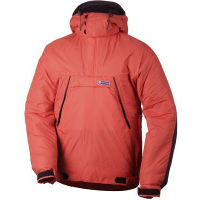
Pile+Pertex Smock Mid Layers
Warmth: High
Warmth-Weight Ratio: Low
Practicality: Very Good
Cost: Medium
What are Pile+Pertex Smocks?
Pile+Pertex Smocks – often called “Buffalos” after the manufacturer of the best known smock – are pull-over tops that are furry on the inside with a nylon shell on the outside.
How do Pile+Pertex Smocks Insulate?
Pile, or fibre pile, works in a similar way to animal fur. It provides insulation against the cold and knits tightly together to retain that insulation when wet. Being made of many small strands allows the pile to dry quickly too and feel less chilly against your skin as the tips dry first.
These smocks also have a shell made of Pertex or a similar nylon material that makes them tougher and offers some wind protection (for more on this, see Andy Kirkpatrick’s history of the smock).
Pros & Cons of Pile+Pertex Smocks
Buffalos are tough, no-nonsense garments. Some people love them as a one-size-fits-all approach which you can get wet, treat roughly, not given a second thought to and still stay warm at the end of it all. Others think you would be better off just having two separate layers that were smaller and lighter.
Their key advantage over synthetic and down jackets, apart from their toughness, is their ability to regulate your temperature. The pile means they wick and breathe much more effectively than down or synthetic jackets (i.e. you won’t get as sweaty) and they generally have long venting zips on both sides, deep chest zips and adjustable cuffs. This means that when it’s really cold you can use these smocks on the move in a way that you can’t with down and synthetic jackets.
The main downside is that they are much bigger and heavier than down and synthetic jackets.
Pile Smock Comparison Table
| Brand | Model | Weight | Ounces | Price | Check price | Notes |
|---|---|---|---|---|---|---|
| Buffalo | Mountain Shirt | 630g | 22oz | £110 | Check price here | The original pile smock |
| Buffalo | Special 6 | 675g | 24oz | £125 | Check price here | Longer cut Mountain Shirt |
| Buffalo | Active | 630g | 22oz | £110 | Check price here | Different, softer, non-Pertex shell |
| Snugpak | Pile Shirt Elite | 1270g | 45oz | £90 | Check price here | Includes hood |
| Montane | Extreme Smock | 1050g | 37oz | £113 | Check price here | Includes hood |
Smock Summary
Bigger and heavier than synthetic jackets but much tougher and good temperature regulation so better for using on the go.
Recommended Smock: Buffalo Mountain Shirt
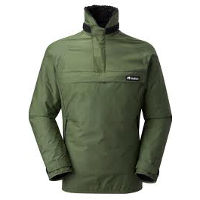
Buffalo are the only manufacturers still consistently making pile+pertex smocks but, thankfully, they’re also the best. I’ve used their Mountain Shirt for many years for winters walking in Scotland and cycling through Iran.
>> Used by the author– >> Rating:![]()
![]()
![]()
![]()
![]()
–
3. Synthetic Insulated Jackets
aka Belay Jackets e.g. Primaloft
–
–
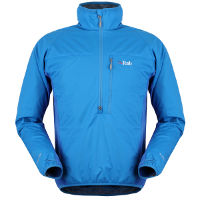
Synthetic Insulated (Primaloft) Mid Layers
Warmth: High
Warmth-Weight Ratio: High
Practicality: Average
Cost: Medium
What are Synthetic Insulated Jackets?
Synthetic jackets – also called “belay jackets” as they are popular with climbers who have to sit still in cold, damp conditions while belaying – are similar to down jackets except that they use a synthetic filling rather than animal feathers and down. They’re much the same as synthetic sleeping bags too.
They tend to have shells made of thin nylon or Pertex which gives them a shiny, plasticy look. They are filled with “synthetic microfibres” which mimic the lofting properties of down while staying resistant to water. The most common brand of this microfibre filling is Primaloft. As such, the tops are sometimes called by a third name: Primaloft jackets.
To recap, synthetic insulated jackets are also called Belay Jackets and Primaloft Jackets, or combination of the three e.g. “synthetic belay jackets” or “insulated Primaloft jackets”.
Pros & Cons of Synthetic Primaloft Jackets
Belay jackets offer a really good level of warmth for very low weights (from 200g or less) and without the fragility and fear of water that you get with down. They also tend to be slightly cheaper. And, as a reasonably new technology, they should only improve with time. As a warm top to put in your bag these are hard to beat.
However, if you are going somewhere dry then a down jacket will give better warmth for its weight. And if you are going somewhere cold and need to exercise in warm clothing then fleece or a pile smock will be much better as belay jackets quickly get very sweaty.
Insulated Jacket Summary
Belay jackets are second only to down for warmth-to-weight but cheaper and not susceptible to water damage. A bit sweaty to walk in though.
Suggested Insulated Jacket: Rab Xenon X
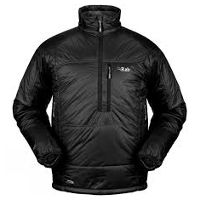
When shopping for an insulated jacket, always compare the type of filling (e.g. Primaloft One or Primaloft Eco) and the quantity of it. There’s no point buying an ultra light jacket if it’s only got 10 grams of insulation.
The Rab Xenon X is an update on the popular Rab Generator which my wife’s had for years. It’s total weight is 342g (12oz), of which the Primaloft Gold insulation is 160g – almost 50%.
>> Excellent fill-to-weight ratio– >> Rating:![]()
![]()
![]()
![]()
![]()
Want One?
–
4. Down Jackets
–
–
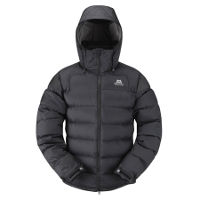
Down Jacket Mid Layers
Warmth: Very High
Warmth-Weight Ratio: Very High
Practicality: Very Poor
Cost: High
What are Down Jackets?
Down is a type of very fine feather which has strong insulating properties. It is particularly useful in outdoor clothing because of its excellent warmth to size and weight ratio. Down jackets are much like down duvets, down pillows and down sleeping bags.
How do Down Jackets Insulate?
The quality of a down jacket (or sleeping bag for that matter) can be assessed on three metrics:
- Down to Feathers Ratio: Fluffy white down is warmer than the actual feathers of an animal but more expensive. As such, a cheaper down jacket might only contain 80% down, with the remaining 20% being feathers, whereas a fancier one might be 95% down.
- Fill Power (“Loft”): Fill Power is a technical measurement for a down’s “loft”, that is, how much space a given weight of it fills. The more space it fills the warmer it will be. A cheaper jacket might have a fill power of 500 and a top quality one might be 800+.
- Animal Pedigree: Different birds from different parts of the world are variously heralded as having the best down. Canadian goose down is a popular choice, for example. Unless you’re a real nerd, this probably isn’t too important beyond the marketing brochure.
Pros & Cons of Down Jackets
Down provides a better insulation for a given size and weight than any other material, natural or man-made. As such, down jackets, salopettes, booties, mittens and suits are popular choices for outdoor pursuits.
The downside is that they are invariably expensive, often a bit fragile (you can get jackets with tougher shells but you start to lose the size and weight benefits then) and highly susceptible to water.
When down gets wet it clumps together and it’s insulating properties plummet. Of coruse, any top that gets wet is not going to insulate you as well but this starts to happen even when down gets just a little damp and the effects can be permanent. It is a delicate process to dry down out without ruining it. Again, it is possible to get down jackets with waterproof shells but that makes them bigger and heavier, and you can still get moisture inside which then becomes doubly difficult to dry properly.
Down Jacket Summary
Down is expensive, fragile and can get ruined if wet but it offers better warmth for weight and size than anything else.
Suggested Down Jacket: Rab Neutrino Endurance
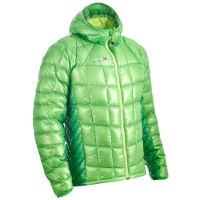
There are so many down jackets on the market that it’s hard to pick out a single product. Just checking the Fill Power is an easy way to gauge the quality (500 is lower quality, 850 is top quality).
I’ve been using my Rab Neutrino Endurance jacket for 14 years everywhere from Siberia to the arctic to cold mornings in Yorkshire. It clocks in at 635g (22oz) of which 250g (9oz) is down. The down is good quality at 800 fill power and the Pertex shell is good for shedding snow.
>> Used by author for 14 years– >> Rating:![]()
![]()
![]()
![]()
![]()
Want One?
Summary
–
Fleece
Fleece is cheap, robust and good in a range of situations but offers only limited insulation and is too bulky to rely on in cold conditions.
Pile Smocks
Bigger and heavier than synthetic jackets but much tougher and good temperature regulation so better for using on the go.
Synthetic Jackets
Insulated jackets are second only to down for warmth-to-weight but cheaper and not susceptible to water damage. Too sweaty to walk in though.
Down Jackets
Down jackets are expensive, fragile and can get ruined if wet but they offer better warmth for weight and size than anything else.
Find that useful? You might like the other articles in my Comparison Series…


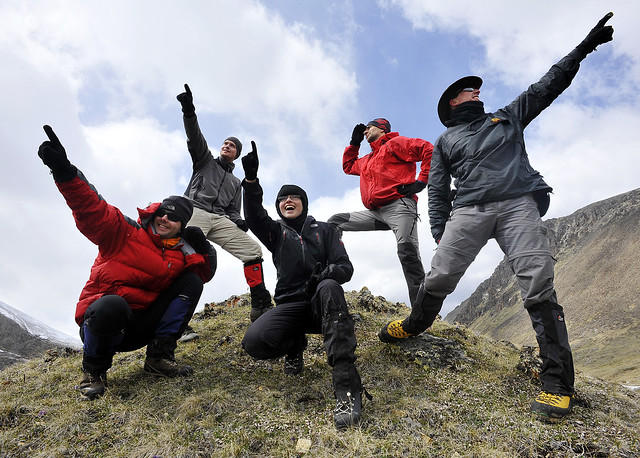
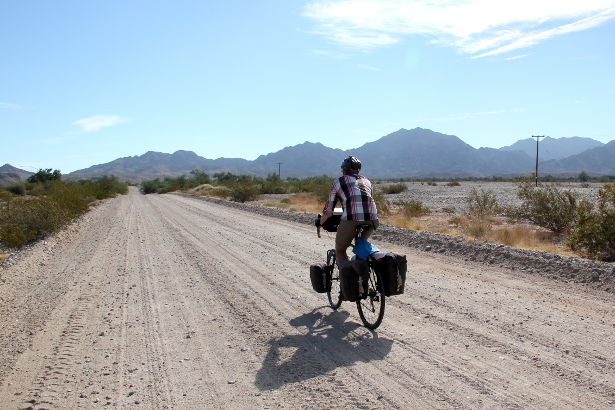
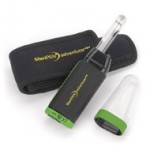
28 Comments
Pingback: The Best Bivy Bags - Comprehensively Reviewed
Pingback: Best Base Layer Materials - Merino, Bamboo, Synthetic & Cotton
Steeeve
Montane makes the extreme smock and jacket which looks very very good on reviews with awesome features
Tim Moss
Thanks Steve. The Montane smock’s good (I mentioned it above). Very similar to the Buffalo but slightly bigger/warmer and comes with a hood included whereas you have to buy the hood as an extra for Buffalos.
knotts
So, my question is, what temperatures are the buffalo smocks rated to? My particular cold weather situation involves remaining still in strong wind at temperatures between -10° and 35°F, so what should I buy?
Tim Moss
Hi Knotts. A Buffalo smock would definitely not be sufficient on its own at -10F (-23C) or below.
Staying warm whilst stationary at those temperatures will require some serious clothing. I’d consider something like a Canada Goose Down Parka.
Underneath that, just some thick, woolly layers e.g. merino, fleece and pile. Buffalo could work but the zips and Pertex make it quite bulky to wear beneath another jacket.
Does that help?
Tim
Hallo Tim, I have a few queries. In your review of mid layers you make no mention of softshells. I am looking at different options at this time but you have thrown up some questions about Primaloft and two Norrona jackets were on my list. So is the Mammut Eigerjoch light jacket and for a softshell Mammut’s Gipfelgrat light jacket. I want something principally for hiking but intensive up and down 5000 feet or more in just over half a day. So it has to breath. What to do? Tim. (Switzerland)
Tim Moss
Hi Tim, thanks for the enquiry. “Softshell” is quite a flexible term but I take it to mean a garments that offer some wind and/or rain protection without the limited breathability of fully waterproof fabrics. The idea behind them is generally that they can be worn in a variety of conditions without having to change all the time. I’m planning a separate article on softshells.
The midlayer materials reviewed here are primarily aimed at insulating (i.e. keeping you warm) and often nothing else. The Buffalo Mountain Shirts could be considered softshell, they just happen to be very warm (though see their full range for lighter options: http://thenextchallenge.org/buffalo).
If you want something for high intensity mountain walking then I think you will want a softshell (like the Gipfelgrat) and not something filled with down/Primaloft (like the Eigerjoch). An insulated jacket like the Eigerjoch or ones reviewed here will just be too hot for walking up hill in Europe (except during very cold winters). In particular, one of the only downsides of Primaloft is that it’s not very breathable so you get extra sweaty (unlike a Buffalo which wicks really well).
I don’t know the Norrona range but it looks like they do all sorts of jackets so just let me know if you want me to look at a particular one.
In summary: go soft shell not insulated jacket (Gipfelgrat not Eigerjoch).
John ware
Excellent roundup here Tim, very useful information. my question is also related to buffalo systems. They are marketed as single layer garments but they also appear to be none waterproof so how do you find them when they get wet?I’m aware they dry quickly but are they actually still warm when the wet stuff is falling? I live in North Wales so temperatures don’t get too low except on the tops but we do get plenty of rain.
Thanks again, John.
Tim Moss
Hi John, you hit on an interesting area. The Buffalo jackets are, in theory, designed as a single layer garment: you wear them next to the skin with nothing else. The idea being that they feel nice, wick very well and can cope with a wide range of temperatures through all their venting options.
However, most people (including me) just wear them like a normal jacket, on top of other clothes. And, when heavy rain comes, we put a waterproof over the top or change jackets. This probably elicits cringes from the designers at Buffalo Systems but I think it’s what most people do.
However, you might like this video from Buffalo Systems themselves:
. A guy wearing a Buffalo Shirt and trousers walks straight into a cold lake then gets out, carries on walking and is warm and dry again within 15 minutes.
I have never got mine sodden so can’t talk from experience about how warm they are in really wet weather. In light rain they’re great. They look like they’re getting very wet, very quickly because the Pertex spreads the water out and darkens. However, it takes a fair while before you feel it and often, in the UK, the rain will have stopped by that point. Also, as discussed in the Andy Kirkpatrick article I linked to above, because the tips of the pile against your skin dry first, *you* feel warm and dry long before the jacket itself is.
In short, Buffalo jackets are designed to get wet and dry out again through your own exertion. Most people either don’t know this or don’t want to risk it but, as the video above suggests, it should work.
Try it. You can always write to Buffalo afterwards if you’re not impressed – they’re a small company and always been very helpful when I’ve contacted them.
(Now, I’m off to the Lakes tomorrow with a wet forecast so maybe it’s time for me to toughen up and get my Buffalo really wet…)
Andrew
Great article Tim.
A confused nubie here.
How do you layer using softshell? I read an article that softshell should be worn below insulation and hard shell should be worn after insulation.
Could you comment on this and explain the logic behind it?
Thanks tim.
Tim Moss
Hi Andrew, thanks for the question. Before I dive in, I should say that you can, of course, wear layers however you like and different people will have different preferences. Indeed, even the designers themselves will have different ideas (see discussion above about Buffalos).
That said, the simple answer to your question is that softshells are designed to be worn as an outer layer. The basic system, ideally, is always:
The reason for softshells going on the outside is that they all have some kind of weather protective layer (e.g. wind/snow/rain proofing) which, obviously, best serves its purpose if it’s exposed to those elements. Underneath another layer, it will be less effective (e.g. that other layer will already be wet before your softshell starts keeping the water out). Additionally, those weatherproof layers on your softshell invariably restrict breathability (less than hard shells but it’s still there). So, not only does the shell not serve its purpose (keeping weather out), it will also make you sweatier than a top that has the insulation but not the shell (i.e. a midlayer).
However, I can think of two reasons why people might talk about putting an insulating midlayer over the top of a soft shell:
First, sometimes it’s just quicker and easier to throw a warm layer over the top rather than removing the softshell, putting on the midlayer then putting on the softshell again only to reverse that process two minutes later. This might be the case if you’re stopping for a short snack on a cold day or you’re stopping to belay on a winter climb, for example. It’s not how the tops are designed and they’re not working optimally but it might just work better in that situation.
Second, one reason softshells get their name is that they are much nicer to touch and wear than hardshells. Whilst you can in theory stick a warm layer over the top of a Goretex jacket, it’s much more comfortable to do the same with a softshell. So, again, whilst that’s not exactly what they’re designed for, it’s certainly an advantage over the hard shells.
Does that answer your question?
Kalel33
You still never fixed the misspelling of “lose”. It’s not spelled “loose”. Two completely different words. “but you start to loose the size and weight benefits”
Tim Moss
Thanks. Typo corrected.
Tim Batterby
Hallo Tim. Thank you for your informative reply to my query about softshells. Interesting! I hadn’t realised that most midlayer jackets, even the lightest, would probably be to warm for intensive excercise. I shall take your advice and probably go for a good softshell. I like the Norrona jacket. (They only make one) but it is a bit lighter than the Mammut Gipfelgrat Light Jacket and it doesn’t have a hood. That said, it looks good and I am sure that it will breathe well.
https://www.norrona.com/en-GB/Products/4016-12/6805/svalbard-flex2-jacket-m/
I just hope it will be tough enough to withstand the odd brush with trees and the wear and tear of carrying a loaded rucksack. On that subject, do you plan on writing an article sometime on rucksacks. Obviously they are an important piece of kit and they vary tremendously. Bach for instance has a small range but the quality is really top notch and their products are not expensive. Arc’teryx even has model sizes according to the length of one’s back! Logical I suppose when one thinks about it as comfort is the vital ingredient there. There’s a super outdoor shop here in Switzerland called Transa. The staff really know what they are doing (they are not simple salespeople) and when one buys a rucksack, they insist that it is loaded so that one has a good idea of what it feels like with weight. Anyhow, I am taking up too much of your time and space. Thank you again. Tim.
Tim Moss
Hi Tim, glad my reply was useful. The Norrona jacket looks nice and, although I’ve not got any clothes using it myself, Polartec Powershield should be tough enough for rucksacks and trees.
Rucksacks – they’re certainly something I could but there are just so many of them and they change so frequently that it might be hard to write anything comprehensive. I prefer to amalgamate quantitative information so readers can compare for themselves and I’m not sure if that would be as useful for bags. It’s a possibility though!
Transa – I agree, it’s fantastic! We visited one when we cycled through Switzerland last and were really impressed. We don’t have anything like that over here.
All the best,
Tim.
Tim Batterby
Hallo again Tim. I just have one more query and then I will leave you in peace – I promise. I know pretty much what I am doing and would choose – and this is obviously personal and based on those clothes that I know – a combination of:
underwear – Icebreaker and Odlo or possibly Mammut depending on whether it is winter or summer; a fleece type midlayer – Norrona and/or Mammut; softshell – Norrona or Mammut; hardshell – R’adys or Norrona or Mammut; trousers – almost all Fjällraven and Norrona; boots and shoes – Lowa and Hanwag. (If anyone is interested I can specify which products.) My question Tim, and here I really don’t know the best solution, is what to use in cold weather as a top layer for when not moving? I presume a down or insulated jacket but which one? It must be big enough to be able to put over the softshell and the other layers and yet not too bulky in the rucksack. I do not want to carry more than a 25 possibly 30 litre pack on a day hike particularly if I am already carrying other winter gear. With kind regards, Tim..
Tim Moss
Hi Tim, you want a warm jacket to wear on a cold day? Have you tried reading the article above? ;)
You’re right that down or Primaloft (type) jackets are the best options. Down tends to be more expensive, a bit fragile and can be ruined by getting damp but has the best warmth-to-weight ratio. Primaloft jackets are basically excellent all round, just not quite as warm for their weight as down (but pretty close).
If in doubt, go Primaloft.
Tim Batterby
Thank you Tim. Yes, I did read the article and very good it is too. I only came back on the question above as some of the insulated jackets are tight-fitting and could not easily be worn over other clothing whereas some of the down jackets are bulky. I also have to take into consideration what is available here in Switzerland though the choice is pretty wide. Anyway, I think I have found something that fits the bill: again a Norrona jacket, Primaloft with a hood. Many thanks. Tim.
andrew
Thanks Tom for your informative reply.
it seems the best selling soft shell is TNF Bionic, which to my eyes looks like a fleece. if i am using lightweight down as mid layer/fleece and TNF Bionic as outter layer for 30C condition windy condition, does it make sense? because to it seems like using 2 fleeces
thanks Tim
Tim Moss
Hi Andrew, North Face say the Apex Bionic is made with “ClimateBlock” which seems to be their own fabric, unique to the jacket (in other words, it tells us very little). To my eye, looking at pictures online, it just looks like a laminated fleece meaning that it will have decent wind resistance and shed a bit of snow rather than sucking it up look a furry fleece does.
The review at Outdoor Gear Lab is not very flattering but then it also says it was their favourite jacket just a couple of years ago so this seems a little fickle. I’d also add that there is probably not a huge amount differentiating a lot of softshells. There’s no wonder fabric so they all just vary slightly on their levels of breathability and wind/water resistance. If you like the feel and fit of the Apex, then go for it. If not, you could try the other two the Gear Lab suggest or pick any with a Pertex outer layer – it’s a great fabric in all its incarnations and certainly doesn’t feel like fleece.
Did you really mean that you’d be wearing a down jacket and a softshell in 30-degree heat? That would, of course, make you very hot! However, the system you’re talking about with a midlayer underneath a softshell is fine. If you’re thinking about using a thick midlayer (like a light downjacket or heavy fleece) then you might consider the super lightweight Pertex smocks e.g. Montane Featherlite as your soft shell.
A long answer but hopefully of some use!
Andrew
Thanks Tim for you time and effort sharing your knowledge! highly appreciated!!
Tim Moss
Entirely my pleasure.
Pingback: Resources from the Cycle Touring FestivalThe Next Challenge | The Next Challenge
Colin
Hi Tim,
I really enjoyed your article, and found it very informative. Do you have any thoughts on what temperature ranges would be appropriate for a 60-g Primaloft Gold (Primaloft One) jacket worn by itself, like the Patagonia Nano Puff? I ask because it is wind proof, and I am thinking of using it as my only insulating layer on my motorcycle trip where temperatures may drop down as low as 45 degrees F. With wind chill calculations, that puts me somewhere around 30 degrees F.
I’ve found it very difficult to get any kind of information on all these jackets that would tell me what temperature ranges they are suitable for. It would be nice if there were some kind of standard that called out suitable “at rest” temperatures as suitable “active” temperatures.
Thanks,
Colin
Tim Moss
Hi Colin
Thanks for the questions. In response:
1: Would a Patagonia Nano Puff be warm enough for motorcycling at 45F (7C), down to 30F with windchill?
Probably not. Primaloft offers excellent warmth for its weight and size but that doesn’t mean the jackets themselves are necessarily that warm. The Nano Puff, for example, only weighs 12oz (340g) so is a tiny, lightweight top. If you just want warmth whilst sat on a motorbike then a big heavy jacket will be better and probably cheaper.
However, if you want to use Primaloft then either get one of the bigger ones or combine with a fleece or a more windproof outer layer over the top. The polyester or Pertex coatings of Primaloft tops will give some wind resistance (as all fabrics do to some extent) but are definitely not complete wind blockers like, say, Goretex or Windstopper.
2. Why is there no standard temperature rating for jackets?
Sleeping bags have a few temperature rating systems which are useful for comparative purposes but don’t often translate into anything directly useful (what does it meant to be “comfortable” at 0 degrees?). And they are far simpler and more consistent than jackets.
I can see that a rating of sorts for jackets could be helpful but given that activity can range from sitting still, to walking, to walking uphill, to running up hill with a pack through mud or similar, it would be really hard to compare. Similarly, some jackets will be sleeveless, have hoods, use draw cords, have high collars, have wind protection and many other variations making comparison even harder. Add that to the already subjective nature of what’s “comfortable” and I think it would be hard to create anything useful.
All of which doesn’t help you very much! With Primaloft, you do at least usually get given the weight of Primaloft used in the jacket which is probably the most reliable way to compare models.
Otherwise, the best advice will just have to be suck it and see.
Good luck!
Pingback: Best Insulating Materials |
Pingback: Best Insulating Materials | Home